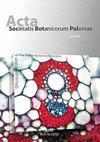地植物学再探——以自然之美及其保护的现实需要为根基的新兴而有影响力的学科掠影
IF 1.1
4区 生物学
Q3 PLANT SCIENCES
引用次数: 3
摘要
洪堡和他的许多继任者的梦想还没有实现。尽管上个世纪的伟大成就,我们仍然不知道植被类型或不同的总数的分布模式的多样性高于和低于地面,我们都无法预测气候变化对植被的影响在地区和全球范围内,我们不知道的隐藏和暗部分物种多样性在大多数生态系统,我们也不能够使历史植被地图地球的许多地区。我们也不知道许多植物群落对人类人口和文明发展的文化贡献,也不知道植被未来的娱乐和治疗潜力(例如,芳香疗法,生态疗法)。地植物学方法可以有效地帮助寻找当前生态学热点问题的答案。由于我们的地球植物学知识还有许多空白,许多年轻的研究人员在看到一望无际的草原、郁郁葱葱的热带雨林、高大的草本植物或五颜六色的草地时仍然高兴得说不出话来,毫无疑问,地球植物学将是一个蓬勃发展的学科。其驱动力是研究人员的热情,对各种植被之美及其动态的钦佩,以及为子孙后代保护它们的必要性的意识。本文章由计算机程序翻译,如有差异,请以英文原文为准。
Geobotany Revisited – A Glimpse at the Blooming and Influential Discipline With Its Strong Roots in the Beauty of Nature and the Pragmatic Need of Its Protection
The dreams of Humboldt and many of his successors have not yet come true. Despite the great achievements of the last century, we still do not know the total number of vegetation types or the difference in the patterns of the distribution of diversity above and below the ground, we cannot predict all the effects of climate change on vegetation at the regional and global scale, we do not know the hidden and dark parts of species diversity in most ecosystems, nor are we able to make historical vegetation maps for many areas of the Earth. We also do not know the cultural contribution of many plant communities for the development of human populations and civilization, nor do we know the future recreational and therapeutical potential of vegetation (e.g., aromatherapy, ecotherapy). Geobotanical methods can effectively contribute to finding the answers to hot questions in current ecology.
Since there are so many gaps in our geobotanical knowledge and so many young researchers still speechless with delight when looking at endless steppes, lush rainforests, tall-herbs, or colorful meadows, there is no doubt that geobotany will be a thriving and developing discipline in the future. Its driving force is the passion of researchers and admiration for the beauty of various types of vegetation and their dynamics as well as awareness of the need to protect them for generations to come.
求助全文
通过发布文献求助,成功后即可免费获取论文全文。
去求助
来源期刊
CiteScore
2.00
自引率
10.00%
发文量
18
审稿时长
1 months
期刊介绍:
The journal has been published since 1923 and offers Open Access publication of original research papers, short communications, and reviews in all areas of plant science, including evolution, ecology, genetics, plant structure and development, physiology and biochemistry.

 求助内容:
求助内容: 应助结果提醒方式:
应助结果提醒方式:


